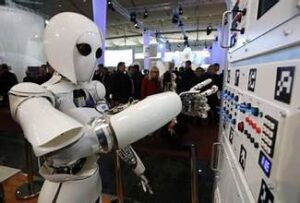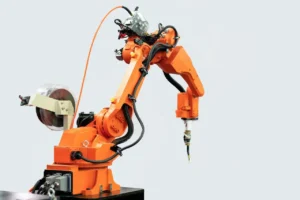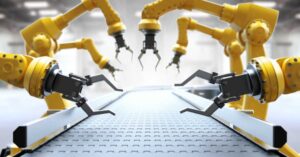Features of Industrial robot
Industrial robots are equipped with sensors, cameras, and advanced control systems to adapt to changing conditions.
Human workers’ roles have been automated in manufacturing through the introduction of industrial robots. These robots excel in tasks such as assembly, welding, painting, packaging, and material handling. Their precision and speed contribute to higher production rates and consistent product quality.

Advantages of industrail robot
1.Better quality and consistency
Along with other tech — such as the industrial internet of things (IIoT) or 3D printing robots — industrial robots are able to provide better production quality and more precise and reliable processes. Added benefits also include reduced cycle times and real-time monitoring to improve preventive maintenance practices.
The advantages of industrial robots include increased efficiency, reduced production costs, enhanced safety by handling dangerous tasks, and the ability to operate continuously without fatigue. Manufacturers can integrate them into existing production lines or design specific applications for them, achieving a high level of customization.
2. Maximum productivity and throughput
It increases speed for manufacturing processes, in part by operating 24/7. Robots don’t need breaks or shift changes. The speed and dependability of robots ultimately reduces cycle time and maximizes throughput.
3. Greater safety
Using robots for repetitive tasks means fewer risks of injury for workers, especially when manufacturing has to take place under hostile conditions. In addition, supervisors can oversee the process online or from a remote location.
4. Reduced direct labor costs
The cost of having a person handle many manufacturing operations is often more expensive than robot. Workers can also be freed up to use their skills and expertise in other business areas, such as engineering, programming and maintenance.
5. Keeping manufacturing in the U.S.
Some argue that robots are taking jobs away from U.S. workers, but that’s not necessarily the case.Humans typically integrate industrial robots into operations that require their expertise. A robot hands off welded parts to a person, who intuitively uses “if, then” thinking to perform the required task.
Advancements in robotics technology, including improved sensors, artificial intelligence, and collaborative capabilities, have marked the evolution of industrial robots.. Collaborative robots, or cobots, are a recent development that can work alongside human operators, promoting a more flexible and cooperative manufacturing environment.
While industrial robots offer numerous benefits, their implementation also raises considerations about job displacement, ethical concerns, and the need for proper training and maintenance. Industrial robots are expected to play an increasingly vital role in shaping the future of manufacturing and industrial processes as technology continues to advance.





Leave a Reply